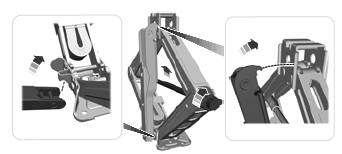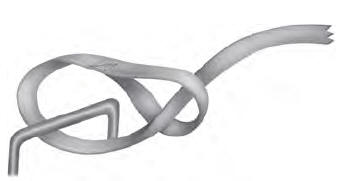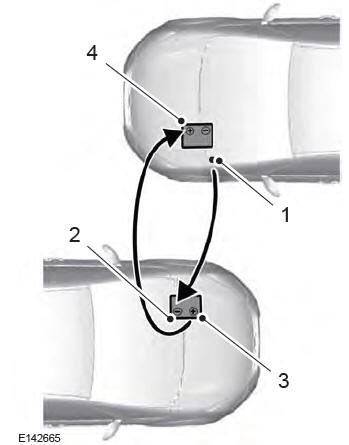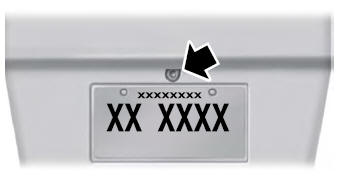Lincoln Corsair: Roadside Emergencies / Jump Starting the Vehicle
WARNING: Batteries normally produce explosive gases which can cause personal injury. Therefore, do not allow flames, sparks or lighted substances to come near the battery. When working near the battery, always shield your face and protect your eyes. Always provide correct ventilation.
WARNING: Keep batteries out of reach of children. Batteries contain sulfuric acid. Avoid contact with skin, eyes or clothing. Shield your eyes when working near the battery to protect against possible splashing of acid solution. In case of acid contact with skin or eyes, flush immediately with water for a minimum of 15 minutes and get prompt medical attention. If acid is swallowed, call a physician immediately.
WARNING: Use only adequately sized cables with insulated clamps.
WARNING: Make sure that the cables are clear of any moving parts and fuel delivery system parts.
Note: Do not attempt to push-start your automatic transmission vehicle. Attempting to push-start a vehicle with an automatic transmission may cause transmission damage.
Note: Do not disconnect the battery of the disabled vehicle as this could damage the vehicle electrical system.
Preparing Your Vehicle
Note: Use only a 12 volt supply to start your vehicle.
Park the booster vehicle close to the hood of the disabled vehicle, making sure the two vehicles do not touch.
Connecting the Jumper Cables
WARNING: Do not connect the negative jumper cable to any other part of your vehicle. Use the ground point.
Note: If you are using a jump pack or booster box, follow that manufacturer's instructions.
Note: In the illustration that follows, the bottom vehicle represents the booster vehicle.

- Pull the red rubber boot backward. Connect the positive (+) jumper cable to the positive (+) terminal of the discharged battery.
- Connect the other end of the positive (+) jumper cable to the positive (+) terminal of the booster vehicle battery.
- Connect the negative (-) jumper cable to the negative (-) terminal of the booster vehicle battery.
- Make the final connection of the negative (-) jumper cable to an exposed metal part of the stalled vehicle's engine, as shown in the following illustration, away from the battery and the fuel injection system, or connect the negative (-) jumper cable to a ground connection point if available.

Starting the Engine
- Start the engine of the booster vehicle and moderately rev the engine, or gently press the accelerator to keep your engine speed between 2000 and 3000 RPM, as shown in your tachometer.
- Start the engine of the disabled vehicle.
- Once you start the disabled vehicle, run both vehicle engines for an additional three minutes before disconnecting the jumper cables.
Removing the Jumper Cables

- Remove the jumper cables in the reverse order that they were connected.
- Remove the jumper cable on the negative (-) terminal of the booster vehicle battery.
- Remove the jumper cable from the positive (+) terminal of the booster vehicle battery.
- Remove the jumper cable from the positive (+) terminal of the disabled vehicle battery.
- Allow the engine to idle for at least one minute.
 Hazard Flashers. Fuel Shutoff
Hazard Flashers. Fuel Shutoff
Hazard Flashers
Note: The hazard flashers operate when the
ignition is in any position, or if the key is not
in the ignition. If used when the vehicle is not
running, the battery loses charge...
 Post-Crash Alert System. Transporting the Vehicle
Post-Crash Alert System. Transporting the Vehicle
Post-Crash Alert System
The system flashes the direction indicators
and sounds the horn (intermittently) in the
event of a serious impact that deploys an
airbag (front, side, side curtain or Safety
Canopy) or the seatbelt pretensioners...
Other information:
Lincoln Corsair 2020-2025 Service Manual: Description and Operation - Brake and Clutch Systems Health and Safety Precautions
WARNING: Do not use any fluid other than clean brake fluid meeting manufacturer's specification. Additionally, do not use brake fluid that has been previously drained. Following these instructions will help prevent system contamination, brake component damage and the risk of serious personal injury...
Lincoln Corsair 2020-2025 Service Manual: Description and Operation - Body - Overview
Insulation Insulation is used as a sound-deadener to reduce exterior road and powertrain noises from the interior of the vehicle. Mastic insulators are also used as insulation. Insulation is installed: under the roof. above and below the instrument panel...
Categories
- Manuals Home
- 1st Generation Lincoln Corsair Owners Manual
- 1st Generation Lincoln Corsair Service Manual
- Programming the Garage Door Opener to Your Hand-Held Transmitter
- Refueling - Gasoline
- Selecting a Drive Mode. DRIVE MODES
- New on site
- Most important about car
360 Degree Camera Cameras
Locating the Rear View Camera

The rear view camera is on the tailgate.
Locating the Front View Camera
